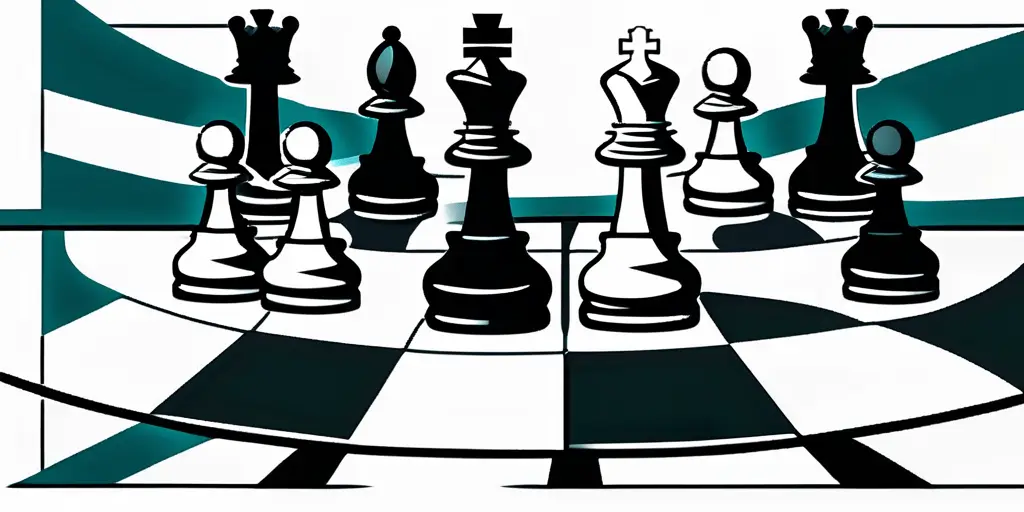In the world of business planning, the terms “strategy” and “tactic” are often used interchangeably. However, these two concepts have distinct meanings and play different roles in achieving organizational goals. In this article, we will explore the fundamental differences between strategy and tactic, their respective roles in business planning, and the interplay between the two.
Understanding the Basics: Strategy vs Tactic
Before delving into the details, let’s first establish a clear understanding of what strategy and tactic mean in the context of business planning.

When it comes to business planning, strategy and tactic are two essential components that work hand in hand to drive an organization towards its goals. While they are often used interchangeably, it is crucial to differentiate between the two to ensure a comprehensive approach to planning and execution.
Defining Strategy
Strategy can be defined as a high-level plan or a set of actions designed to achieve long-term goals. It involves making strategic choices to allocate resources, define target markets, develop competitive advantages, and position an organization for long-term success. Strategy provides a roadmap for the organization, guiding decision-making processes and shaping the direction of the company.
Developing a robust strategy requires a deep understanding of the market landscape, competitive forces, and internal capabilities. It involves analyzing trends, forecasting future scenarios, and identifying opportunities for growth and innovation. A well-crafted strategy serves as a guiding light for the organization, helping leaders make informed decisions and stay ahead of the competition.
Defining Tactic
On the other hand, a tactic refers to a specific action or maneuver taken to achieve short-term objectives within the broader strategic framework. Tactics are more focused and operational in nature, aimed at executing the strategic plan effectively. They are implemented on a day-to-day basis and are often subject to change based on immediate circumstances.
Unlike strategy, which focuses on the big picture and long-term goals, tactics deal with the nitty-gritty details of implementation. They involve tasks such as pricing strategies, promotional campaigns, product development initiatives, and customer engagement tactics. Effective tactics are crucial for translating strategic vision into tangible results and driving the organization towards its overarching goals.
The Role of Strategy in Business Planning
Strategy plays a crucial role in business planning, providing a long-term perspective and guiding decision-making processes. Let’s explore two key aspects of strategy in greater detail.
The Long-term Perspective of Strategy
One of the fundamental characteristics of strategy is its focus on the long-term. Strategic decisions are made with a vision of the future, with an emphasis on sustainable competitive advantage and overall organizational success. Strategy looks beyond immediate gains and considers the larger picture.
When we delve into the world of strategy, it becomes apparent that successful companies understand the importance of long-term thinking. They recognize that short-term gains may provide temporary success, but it is the long-term vision that truly propels them forward. Take Apple Inc. as an example. Their strategy is centered around innovation and creating a seamless user experience. This long-term vision has guided the development of products like the iPhone, iPad, and Apple Watch, which have revolutionized the tech industry. By constantly pushing the boundaries of technology, Apple has secured its position as a leader in the market, captivating consumers with their forward-thinking approach.
The Importance of Strategy Alignment
Another crucial role of strategy in business planning is aligning various elements of the organization towards a common goal. Effective strategy alignment ensures that resources, activities, and processes are coordinated and directed towards achieving desired outcomes.
Imagine a symphony orchestra where each musician plays their own tune without any synchronization. The result would be a cacophony of dissonance. Similarly, in the business world, strategy alignment is like the conductor who brings harmony to the organization. Southwest Airlines provides a classic example of strategic alignment. Their strategy of low-cost flights combined with friendly service has permeated every aspect of their operations, from the hiring process to the selection of aircraft. This alignment has helped them build a strong brand and maintain a competitive edge in the airline industry. By aligning their resources, processes, and customer service, Southwest Airlines has created a seamless experience for their passengers, earning them a loyal customer base.
Strategy alignment goes beyond just coordinating activities; it fosters a sense of unity and purpose within the organization. When everyone is working towards a common goal, it creates a synergy that propels the company forward. This alignment not only enhances efficiency but also boosts employee morale and satisfaction, leading to a more productive and successful organization.
The Role of Tactics in Business Planning
While strategy provides the overall direction, tactics contribute to the execution and implementation of the strategic plan. Let’s explore two important aspects of tactics in business planning.
The Short-term Focus of Tactics
Tactics are designed to achieve short-term objectives in a timely and efficient manner. They focus on the immediate needs of the organization and are subject to change based on market conditions and internal factors. Tactics are nimble and adaptable, allowing organizations to respond quickly to emerging trends and opportunities.
For instance, consider the marketing efforts of Coca-Cola. While their overall strategic goal is to maintain brand dominance, their tactical approaches vary based on regional preferences, cultural contexts, and current trends. This flexibility enables them to adapt their marketing campaigns to specific markets, ensuring maximum impact.
In one market, Coca-Cola may emphasize the refreshing taste of their beverage during hot summer months, while in another market, they may highlight the nostalgic appeal of their brand to resonate with a particular demographic. By tailoring their tactics to suit the unique characteristics of each market, Coca-Cola can effectively connect with consumers and drive sales.
The Flexibility of Tactics
Unlike strategy, which is relatively fixed and long-term, tactics are flexible and can be adjusted as needed. This adaptability allows organizations to respond to changing circumstances and seize opportunities in real-time. Tactics can be refined based on feedback, learnings, and evolving market dynamics.
An excellent example of tactical flexibility is Netflix’s transition from a DVD rental service to a streaming platform. Initially, their strategy revolved around mail-order DVD rentals, which was a popular choice at the time. However, with the rise of digital streaming, they swiftly shifted their tactics to embrace the emerging trend.
Recognizing the potential of streaming, Netflix invested heavily in building a robust online platform, securing licensing deals with content providers, and developing a user-friendly interface. This tactical pivot allowed them to stay relevant in an ever-changing industry and become a global streaming giant.
Moreover, Netflix’s ability to adapt their tactics extended beyond technological advancements. They also demonstrated flexibility in content creation and distribution. By analyzing user data and preferences, Netflix strategically produced original content tailored to different demographics and regions. This personalized approach to content creation further solidified their position as a leader in the streaming industry.
Key Differences Between Strategy and Tactics
Now that we have explored the individual roles of strategy and tactics, it’s essential to understand the key differences between these two concepts. Let’s examine three critical distinctions.
Time Frame: Long-term vs Short-term
One of the primary differences between strategy and tactics is their time frame. Strategy focuses on the long-term, providing a roadmap for achieving overarching goals. Tactics, on the other hand, have a short-term focus and are implemented to meet immediate objectives.
Consider a retail company aiming to expand its market presence. The strategy may involve opening new stores, entering new markets, or developing an e-commerce platform. The tactics, however, could involve promotional campaigns, sales events, or loyalty programs aimed at driving short-term sales and customer engagement.
For example, the retail company’s strategy might include a five-year plan to expand into new regions and capture a larger market share. The tactics, on the other hand, could involve running limited-time offers, partnering with local influencers for brand exposure, or launching targeted social media campaigns to attract new customers in the short term.
Scope: Broad vs Narrow
Strategy is broad in scope, encompassing the entire organization and its future direction. It considers factors such as market analysis, competitive positioning, product development, and resource allocation. Tactics, on the other hand, are narrow in scope and focus on specific actions and initiatives to achieve short-term goals.
For instance, a technology company’s strategy might involve expanding its product portfolio to cater to different customer segments. The tactics, however, could involve conducting market research, developing targeted advertising campaigns, or partnering with influencers to raise awareness and drive sales for specific products.
Let’s say the technology company’s strategy includes a three-year plan to enter new markets and diversify its offerings. The tactics, in this case, could involve conducting focus groups to understand customer preferences, collaborating with design agencies to create visually appealing product packaging, or launching a series of product demonstrations to generate buzz and attract potential buyers.
Flexibility: Fixed vs Adaptable
While strategy provides a long-term direction, it tends to be relatively fixed and less adaptable. Tactics, on the other hand, offer flexibility and can be adjusted as circumstances change. Tactics are responsive to immediate market conditions and can be refined or revised to maximize results.
Take the example of Airbnb. Their overall strategy is to disrupt the traditional hospitality industry by connecting travelers with unique accommodations. However, their tactics have evolved over time to address changing consumer preferences, regulatory challenges, and global events. This tactical adaptability has allowed Airbnb to navigate obstacles and thrive in a dynamic marketplace.
For instance, Airbnb’s strategy may include a ten-year plan to expand into new markets and establish themselves as a global travel brand. The tactics, however, could involve launching localized marketing campaigns to target specific regions, partnering with local tourism boards to promote unique experiences, or introducing new features on their platform based on user feedback and market trends.
The Interplay Between Strategy and Tactics
While strategy and tactics may seem distinct, they are interconnected and rely on each other for effective implementation and success. Let’s explore two ways in which strategy and tactics interact.
How Strategy Shapes Tactics
Strategy provides the overarching framework within which tactics operate. It sets the direction, defines the goals, and determines the resources available for tactical execution. Without a clear strategy, tactics lack purpose and cohesion, leading to haphazard and ineffective decision-making.
An excellent illustration of strategy shaping tactics is Tesla’s approach to the electric vehicle market. Their strategy is centered around accelerating the world’s transition to sustainable energy. This strategic goal has shaped their tactics, including the development of high-performance electric vehicles, building a global charging infrastructure, and investing in renewable energy solutions.
By focusing on sustainable energy, Tesla’s strategy has influenced their tactics in numerous ways. For instance, their decision to prioritize the development of high-performance electric vehicles is a direct result of their strategy to showcase the potential of sustainable transportation. Additionally, their investment in a global charging infrastructure is a tactical move to address the concern of range anxiety, making electric vehicles more accessible and convenient for consumers worldwide.
How Tactics Support Strategy
While strategy provides the vision, tactics are instrumental in executing the strategic plan effectively. Tactics support strategy by translating abstract goals into concrete actions, ensuring alignment with the broader organizational objectives. Effective tactical implementation brings the strategic vision to life and drives progress towards desired outcomes.
Consider Amazon’s strategy of becoming the “everything store” and providing a seamless shopping experience. Their tactics include personalized recommendations, fast shipping options, and an easy-to-use interface. These tactics not only align with the strategic vision but also contribute to creating a superior customer experience that sets Amazon apart from its competitors.
Amazon’s tactical approach of personalized recommendations is a direct support to their strategy of being the go-to destination for all customer needs. By leveraging data and algorithms, Amazon tailors product suggestions to individual preferences, enhancing the overall shopping experience and increasing customer satisfaction. Similarly, their fast shipping options, such as Amazon Prime, align with their strategy of convenience and promptness, ensuring that customers receive their orders quickly and reliably.
Furthermore, Amazon’s easy-to-use interface is a tactical choice that supports their strategy of providing a seamless shopping experience. By designing an intuitive and user-friendly platform, Amazon eliminates barriers to purchase, making it effortless for customers to find and buy products. This tactical decision not only enhances customer satisfaction but also reinforces Amazon’s position as a leader in the e-commerce industry.
Common Misconceptions About Strategy and Tactics
Despite their distinct meanings, strategy and tactics are often misunderstood or misinterpreted. Let’s address two common misconceptions and clarify the differences between the two concepts.

Misconception 1: Strategy is More Important Than Tactics
It is a common misconception that strategy takes precedence over tactics. In reality, both strategy and tactics are essential and synergistic components of effective business planning. Strategy provides the overall direction, while tactics ensure the successful execution of the strategic plan.
Think of strategy as the compass that guides the organization’s journey, and tactics as the fuel that propels it forward. One without the other limits the organization’s potential for success.
However, it is important to note that the balance between strategy and tactics may vary depending on the context. In certain situations, such as during times of crisis or rapid change, tactics may take a more prominent role in adapting and responding to immediate challenges. On the other hand, during periods of stability and long-term planning, strategy may play a more significant role in shaping the organization’s direction.
Misconception 2: Tactics are Just Short-term Strategies
Another misconception is considering tactics as equivalent to short-term strategies. While tactics do have a short-term focus, they are not synonymous with strategy. Tactics are specific actions and initiatives aimed at achieving immediate goals, while strategy provides a broader framework for long-term success.
To illustrate, a soccer team employing a specific set play during a match is a tactical decision aimed at scoring a goal. However, the team’s overall strategy might involve a combination of tactics, such as possession-based play, counter-attacks, and defensive solidarity, to achieve long-term success in the league.
It is crucial to recognize that tactics should always align with the overarching strategy. Without a clear strategic direction, tactics may become disjointed and fail to contribute to the organization’s long-term goals. Therefore, it is important for businesses to invest time and effort in developing a robust strategy that can guide and inform tactical decisions.
Concluding Thoughts: The Balance Between Strategy and Tactics
As we conclude our exploration of strategy and tactics, it becomes evident that both concepts are integral to effective business planning. Strategy provides a vision for the future, while tactics contribute to the execution of the strategic plan.

The key lies in striking the right balance between strategy and tactics. Organizations must develop a robust strategic framework and align tactical implementation with the broader goals and objectives. By understanding the differences between strategy and tactics and harnessing their interplay, organizations can navigate the complexities of the business landscape and set themselves up for sustainable success.
Just as a well-defined strategy and precise tactics are crucial for business success, the same applies to cybersecurity. At Blue Goat Cyber, we understand the importance of a strategic approach to cybersecurity, especially when it comes to protecting medical devices and ensuring compliance with industry standards like HIPAA and FDA regulations. Our veteran-owned business is dedicated to providing top-tier B2B cybersecurity services, including penetration testing and compliance assessments, to keep your business one step ahead of attackers. Contact us today for cybersecurity help and let us help you secure your business with a strategic cybersecurity plan tailored to your needs.


